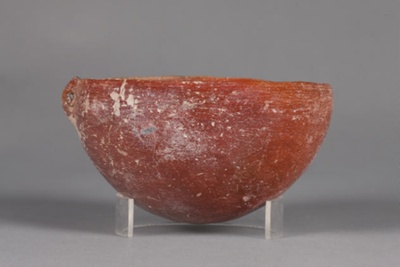< Collection search
< Collection highlights
From:UC Teece Museum of Classical Antiquities
Name/TitleBowl
About this objectKnown as a knob-lug bowl, this hemispherical clay bowl has a rounded base. The lug, or small knob, is attached to the rim. It has been shaped around a stick to create a suspension hole for hanging. The bowl is covered in a red slip that has some black patches on the outer surface, mostly on one side.
Shapes like this are often created by moulding clay around a gourd or other spherical object. This allows the maker to get an even thickness for the walls without compromising the circular shape. Knob-lug bowls were a common find in Bronze Age Cypriot sites. They were used as eating bowls, and hung away when not in use. This bowl was discovered in a tomb in Lapatsa, in northern Cyprus, with several others that are also part of the Logie Collection.
Date Madeca. 21st Century BC
PeriodEarly Cypriote
Place MadeCyprus
Place NotesExcavated from Karmi - Lapatsa tomb 11
Medium and MaterialsCeramic: Pottery
Style and IconographyCypriote
Style and IconographyRed polished III
TechniqueMolding (forming)
TechniqueGlazing (coating process)
TechniqueSlab method (pottery technique)
MeasurementsHeight 74mm; Diameter 134mm
Subject and Association KeywordsMourning customs
Subject and Association KeywordsFood history
Named CollectionThe James Logie Memorial Collection, University of Canterbury, New Zealand
Credit LineDonated by the Melbourne University Cyprus Expedition, care of Dr J.B. Hennessy, University of Sydney, 1973.
Object TypeFood Service Vessels
Object number132.73
Copyright LicenceAll rights reserved
